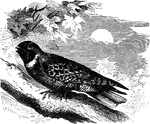Clipart tagged: ‘night-jar’

Nightjar
The Night-jar is a bird of evil omen in the estimation of our rural population. The reverse should be…

Large Whippoorwill
"Antrostomus vociferus. Whippoorwill. Night-jar. Upper parts variegated with gray, black, whitish, and…

Small Whippoorwill
"Antrostomus vociferus. Whippoorwill. Night-jar. Upper parts variegated with gray, black, whitish, and…